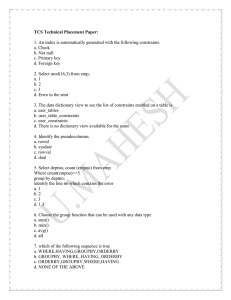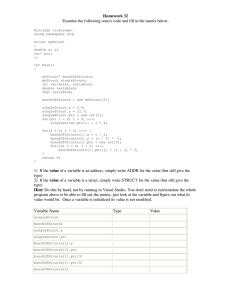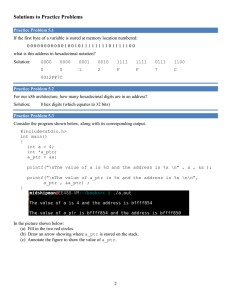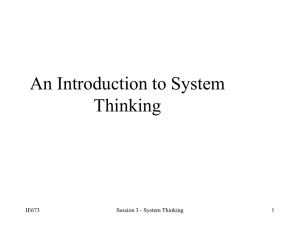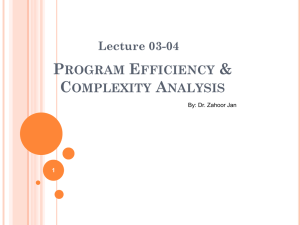Algorithm Analysis 2P03
advertisement
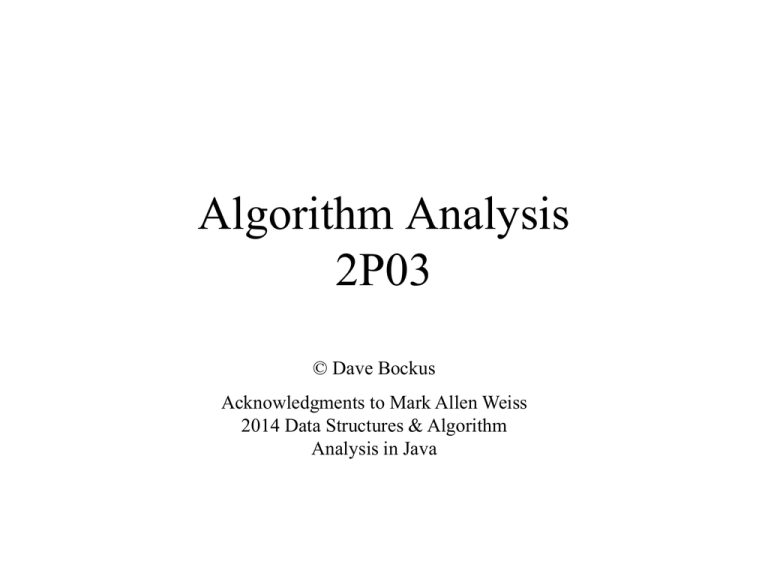
Algorithm Analysis
2P03
© Dave Bockus
Acknowledgments to Mark Allen Weiss
2014 Data Structures & Algorithm
Analysis in Java
Strategies for Analyzing Code
Rule 1-- FOR LOOPS: The running time of a FOR loop
is at most the running time of the statements inside the
FOR loop (including tests) times the number of
iterations.
Rule 2-- Nested Loops: The total running time of a
statement inside a group of nested loops is the running
time of the statements multiplied by the product of the
sizes of all the loops.
for (i=0; i < n; i++)
Running time
for (j=0; j < n; j++)
nxn
sum++;
Strategies for Analyzing Code Cont...
Rule 3-- Consecutive Statements: Statements
simply add up, where the largest statement takes
precedence.
for (int i = 0; i < n; i++) Statements A
sum++;
for (int i = 0; i < n; i++)
for (int j = 0; j < n; j++) Statements B
sum++;
• Total running time is determined by statement set
B
Strategies for Analyzing Code Cont...
Rule 4-- If/Else: Running time of an IF/ELSE is
never more than the running time of the test plus
the larger of the running times of S1 and S2.
If (condition)
S1
Else
S2
If (condition)
for (int i = 0; i < n; i++)
sum++;
Else
for (int i = 0; i < n; i++)
for (int j = 0; j < n; j++)
sum++;
Worst case is condition + S2 = O(n2)
Strategies for Analyzing Code Cont...
• Loops where the problem N size is divided by
some factor k is a logkN loop.
for (int i = 0; i < n; i++){
n = n/3;
sum++;
}
– Running time is log3N
• or
– Just O(log N)
Strategies for Analyzing Code Cont...
Analyze loops from the inside out.
Recursion:
Tail recursion is nothing more then a LOOP.
PrintList (node ptr){
if (ptr != null) {
print(ptr.data);
PrintList(ptr.next);
}
}
PrintList (node ptr){
while (ptr != null){
print(ptr.data);
ptr = ptr.next;
}
}
Other types of recursion may require recurrence
relations to be defined.
Partitioning a List
Given a List:
[3
7
2
4
6
1
5]
Take first # or choose a pivot element
Put everything less than this in a left sublist
Put everything greater than this in a right sublist
Keep doing this for each sublist
E.g. The above partitions into:
[2
1]
3
[ 4 6 7 5]
Partitioning a List Cont…
[3
7
2
4
6
1
i
1). While jth element > ith element, reduce j
[3
7
2
4
6
1
i
j
2). Swap the ith and jth elements
[1
7
2
4
6
3
i
j
5]
j
5]
5]
3). While ith element <= jth element, increase i
[1
7
2
4
6
3
5]
i
j
4). Swap the ith and jth elements
[1
3
2
4
i
5). Repeat 1 to 4 until j=i
6
7
j
5]
Partitioning a List Cont…
Step 3
[3
i
[3
i
[1
i
[1
Step 4
[1
Step 1
[1
Step 1
[1
Step 1
[1
Step 1
Step 2
Step 2
Step 3
Finished
[1
[1
7
2
4
6
1
7
2
4
6
7
2
4
6
7
i
3
i
3
i
3
i
3
i
2
i
2
4
6
2
4
6
2
4
2
4
j
4
6
j
6
1
j
3
j
3
j
7
j
7
2]
3
i=j
2
j
3
j
5]
j
5]
5]
5]
5]
5]
7
5]
6
7
5]
4
6
7
5]
[4
6
7
5]
Best Case for Quick Sort
• Alternately we can use a recurrence relation
LHS: with i elements
– T(N) = T(i) + T(N – i – 1) + cN
• So
RHS: with N-i
elements
Number of
comparison for
pivot – constant
time.
– T(N) = 2T(N/2) + cN
– T(N)/N = T(N/2)/(N/2) + c Multiply both sides by 1/N
Best Case QS Continued ...
• Cut list in ½ for each iteration until 1 element in
partition
–
–
–
–
T(N)/N = T(N/2)/(N/2) + c
T(N/2)/(N/2)= T(N/4)/(N/4) + c
T(N/4)/(N/4)= T(N/8)/(N/8) + c
T(N/8)/(N/8)= T(N/16)/(N/16) + c
• at some point
– T(2)/(2)= T(1)/(1) + c
Best Case QS Continued ...
• If we add up all equations:
– T(N) + T(N/2) … T(2) = T(N/2) … T(2) +T(1) + clgN
N + N/2 + N/4 … 2
N/2 + N/4 …2+ 1
• Cancel out terms:
– T(N) = T(1) + clgN
N
1
– T(N) = NT(1) + cNlgN
• T(1) is 1 so:
– T(N) = N + cNlgN
• so order NlgN
Worst Case for QS
Pivot
– T(N) = T(N-1) +cN
N>1
• Reducing the list by choosing the smallest
– T(N-1) = T(N-2) + c(N-1)
– T(N-2) = T(N-3) + c(N-2)
• until
– T(2) = T(1) +c(2)
Worst Case for QS
• Now add up all equations
– T(N) + T(N-1) - T(1) = T(N-1) + c N
– T(N) = T(1) + cN
– T(N) = 1 + cN(N+1)/2
• or
– T(N) = O(N2)
Exercise: Bubble Sort
• Determine the run time equation and complexity of
bubble sort?
for (i=1; i<=n; i++)
for (j=1; j<n; j++) {
{compare & swap}
if (x[j] > x[j+1])
swap
}
The basic BS compares every element with every other
element.
Each time through the loop n elements are compared.
Since we do this n times there are n x n or n2 comparisons.
Runtime equation is f(n) = n2 with On2 complexity
Exercise: Nexted Loops
• Determine the run time equation and complexity
of the following code? What is the value of sum if
n = 20.
for (int i=1; i<=n; i++)
for (int j=1; j<=i; j++)
sum++;
Exercise: Nexted Loops Cont….
• We must note that the inner loop will increase sum i
times each time it executes.
– So after 6 iterations of the inner loop, sum is 1 + 2 + 3 + 4 +
5 + 6, this happens to be the sum of n numbers:
n = [n(n+1)]/2
if n = 20 then
= 20(21)/2
= 210
Running the code
n = 1 -- sum is
n = 2 -- sum is
n = 3 -- sum is
n = 4 -- sum is
n = 5 -- sum is
n = 6 -- sum is
n = 7 -- sum is
n = 8 -- sum is
n = 9 -- sum is
n = 10 -- sum is
1
3
6
10
15
21
28
36
45
55
n = 11 -- sum is
n = 12 -- sum is
n = 13 -- sum is
n = 14 -- sum is
n = 15 -- sum is
n = 16 -- sum is
n = 17 -- sum is
n = 18 -- sum is
n = 19 -- sum is
n = 20 -- sum is
66
78
91
105
120
136
153
171
190
210
